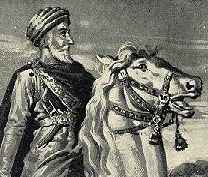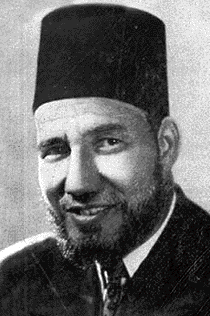|
Then and Now: The Missing LinkA direct connection between the 11th-century Assassins cults and al Qaeda would be a conspiracy theorist's dream come true. Unfortunately, the intense secrecy around both groups and the passing of nearly 1,000 years of history makes a link virtually impossible to prove.It's much easier, however, to show whether it could be true. The story captures the imagination in much the same way as the real-life historical theories behind The DaVinci Code. And along the way, the theory might offer an important insight into the War on Terrorism, surely the great challenge of our times. In comparing the Assassins to al Qaeda, there are four key points of convergence:
A Tale Of Two HassansHassan I-Sabbah, the founder of the Assassins, was born near Tehran during the 11th century. He received a religious education in Shi'a Islam and was exposed to the Ismaili sect at an early age.The Shi'ites believed that the Islamic state should rightfully be led by the descendents of Ali, the son-in-law of the Prophet Muhmmad. The Ismailis supported leaders, known as Fatimids, who claimed a specific line of descent from Ali after an eighth-century dispute over succession. After splitting from the Shi'ites, the Ismailis took a more mystical turn, integrating elements of Gnosticism and Greek philosophy.
al-Azhar was established as a university in the late 10th century and quickly became a leading educational institution. Ismaili dais were educated at al-Azhar, in a special wing known as Dar al-Hikma, which was dedicated to revealing the sect's inner teachings. The main university was open to the public and put forward a more ecumenical face. At the time of Hassan's trip to Cairo, the Ismailis were in the middle of a schism over the succession of the caliphate. Hassan supported Nizar ibn al-Mustansir, whose name was eventually lent to the Assassin cult, the Nizaris. Hassan was deported from Egypt for supporting Nizar. After traveling in search of converts for a few years, he took control of the fortress of Alamut in what is now Iran, and the Assassins were born. Almost 900 years later, another Hassan emerged in Egypt as the leader of a potent Islamic secret society. Born in 1906, Hassan al-Banna was the son of a watchmaker who grew up to be a schoolteacher. Al-Banna's father was an alumni of al-Azhar University. The histories differ as to whether al-Banna himself ever attended the university, but certainly it would come to dominate his attention in the years that followed.
At the age of 16, according to legend, al-Banna had memorized the entire Koran. He founded the Muslim Brotherhood in 1928 to promote Islamic values. Like his namesake, Hassan traveled the world in search of new members for his organization, setting up branches in several countries around the Middle East. Al-Banna and his new Brotherhood set their sights on Al-Azhar—blasting the clerics there for allowing Western cultural influences to seep into Egypt. In addition to his outward polemics, al-Banna seeded his fledgling group's membership into al-Azhar circles, correctly intuiting that the ancient school would provide the ultimate platform for leveraging his increasingly radical beliefs into the wider Islamic world. In the late 1940s, the establishment of the state of Israel sparked a regional war, and within that violent conflict, the Brotherhood suddenly emerged as a militant political group, using violence to further its goal of establishing Islamic governments in the region. In pursuit of its modern goals, al-Banna's organization employed an ancient tool—assassination. Like Hassan I-Sabbah, al-Banna sought to reshape the political fortunes of the Middle East through strategic killing, such as the 1948 assassination of Egyptian prime minister Mahmud Fahmi Nokrashi, committed by a member of the Brotherhood. Unlike the leader of the Assassin cult, al-Banna did not have a fortress to protect him from the consequences of his killings. al-Banna died at the hands of the Egyptian government one year later.
The Missing LinkCombined with the other points of convergence between al Qaeda and the Assassins, Cairo offers the possibility of a missing link between the ancient cult and the modern scourge.Each Hassan had an intimate relationship with the University of al-Azhar, albeit with a millennium between them. And the Muslim Brotherhood members who infiltrated al-Azhar starting in the days of al-Banna played a central role in the development of al Qaeda. The Muslim Brotherhood runs like a colored thread through the fabric of al Qaeda. A young Osama bin Laden was introduced to fundamentalist Islam by a Muslim Brother, and when he went to Afghanistan, he was the protege of jihadist Abdallah Azzam, another member of the organization and a former student at al-Azhar.
The architects of modern jihadi theology—Sayyid Qutb and Abd al-Salam Faraj—were both members of the Brotherhood. Sheikh Ahmed Yassin, the founder of Hamas, was both a member of the Brotherhood and an al-Azhar alumni. The infiltration of the Brotherhood into Egyptian society resembles Hassan I-Sabbah's covert infiltration of Alamut in the 11th century. Through misdirection and sometimes outright deception, the Brotherhood has established a stronghold of sorts in the middle of a country considered to be one of America's most steadfast allies in the Middle East. According to Mary Anne Weaver, author of A Portrait of Egypt: Al-Azhar had long been a prime recruiting ground for the Muslim Brotherhood, and its graduates had, in turn, reexported the Brotherhood's brand of militant Islam throughout the Middle East. What is far more worrisome, however, to Egyptian secularists is the Brotherhood's recent success—thanks largely to Saudi funding—in recruiting prominent sheikhs from within al-Azhar itself. The sheiks have then, in turn, infiltrated the Egyptian courts in their efforts to implement Shariah law. The notion that some sort of secret society with ties to the Assassins could have endured for 1,000 years in Cairo, in the vicinity of al-Azhar University, is not as outrageous as it sounds. After all, al-Azhar itself has endured that long. Like our theoretical society, al-Azhar has survived and thrived. Like our secret society, al-Azhar has metamorphosed from a Shi'ite institution into a Sunni institution. And like our secret society, al-Azhar has spread its influence around the globe to dramatic effect even in this modern, secularized world. Perhaps our long-lost Assassin sect exists side-by-side with the University, waiting on the sidelines to single out the best of the intellects who make their way to al-Azhar—in much the same way Skull and Bones taps the shoulders of elite students at Yale, without the formal sanction of the university. The Secret of al Qaeda's SuccessIf al Qaeda and the Assassins share a possible geographical center, structural elements and theological tenets, the question that remains is still daunting: What mechanism could ensure the survival of a secret sect for so long? How could such a society remain concealed for so long? A romantic appeal to the legendary proficiency of the Assassins isn't enough. A practical description is required.Fortunately, al Qaeda itself provides a template for how this theoretical secret sect could survive The War on Terrorism has provided an unparalleled opportunity to see how the secret society model functions over time and under intense pressure. The development of al Qaeda over the approximately 20 years of its history can be charted simulate, to an extent, the pressures that a secretive sect might face over the course of a much longer time. Since its founding, al Qaeda has primarily been an aggregator of terrorist groups. Although it exists as a terrorist cell in its own right, the network's function is more often to support and coordinate the efforts of other terror groups, while creating entirely new organizations with links back to the original. In its early days, al Qaeda worked with pre-existing terror groups like Egyptian Islamic Jihad, Ayman Al-Zawahiri's terrorist organization. Conventional wisdom says al Qaeda was founded in 1989, and that it merged with EIJ in 1998. But the pattern of activity argues for much earlier dates for both those events. By the late 1980s, EIJ had a sweeping network of sleeper agents in place within the United States, and those agents worked closely with figures now known to be associated with al Qaeda. bin Laden and Zawahiri first met in 1987, according to Washington Post editor Stephen Coll's Ghost Wars.
At first, al Qaeda's function was to absorb these other organizations. A southeast Asian militant named Hambali fought in Afghanistan in the mid-1980s, where he encountered bin Laden and attended al Qaeda's training camps. There, like others who attended the camps, he was indoctrinated into the core al Qaeda group. In the early 1990s, Hambali was sent back to Asia, where he rejoined Jemaah Islamiah, the group he had originally belong to. Armed with bin Laden's cash and the connections he made in Afghanistan, Hambali took over JI in short order, transforming it into al Qaeda's affiliate in the region. In addition to working with existing terror organizations like EIJ, the young al Qaeda group sponsored the formation of new groups. In the late 1980s, perhaps even earlier than the commonly accepted date of al Qaeda's founding, bin Laden invested in the Philippines. First, he funneled money to the Moro Islamic Liberation Front, a local militant group that had operated for more than a decade. A few years later, a veteran of the Afghanistan camps split the Abu Sayyaf Group off from MILF, resulting in a new organization more directly under al Qaeda's control. As in New York, Ramzi Yousef and KSM traveled to the Philippines to coordinate massive terrorist attacks on the U.S. with the help of the local network. In turn, Yousef helped train new Filipino recruits at bin Laden-sponsored camps in the country. al Qaeda is a generator of terrorist groups. When the organization is pressured, it splits off segments, or seeds, which grow into semi-autonomous operations. This process has accelerated in recent years, since the U.S. invasion of Afghanistan. In August 2004, the Associated Press reported: The emergence of small, little known groups with ideologies like al-Qaida's has made the fight against terrorism a far more daunting task. Instead of targeting just al-Qaida, the West and its allies now face many "al-Qaidas," splinter groups that are mostly unrelated to each other but are bound by the same hatred of the West—especially the United States and its allies, including Israel. The groups are small, little known and highly militant. [...] Except that there may be a central nervous system after all. The example of al Qaeda and EIJ above is telling. Although there are numerous proven direct links between EIJ and al Qaeda starting no later than the early 1990s, virtually every source dates the "merger" between the groups to 1998. If you pull back to look at the big picture, including Muslim Brotherhood linkages, the integration of the two organizations looks like a much earlier event, perhaps as early al Qaeda's founding in the mid-1980s.
From The Root Finally, we must delve into an entirely speculative zone to answer the original question. How could al Qaeda be a direct descendent of the Assassins?
Finally, we must delve into an entirely speculative zone to answer the original question. How could al Qaeda be a direct descendent of the Assassins? Perhaps both groups grew from the same root. What if there were a core Islamic militant sect, call them the "Assassins Prime," a sect buried in so many layers of misdirection and initiation that only a very few even became aware of its existence? The Assassins and al Qaeda have each in their own way proven that the sectarian difference between Sunni and Shi'ite isn't insurmountable, the example of al-Azhar shows it even more clearly. The Assassins Prime are not constrained by sect, school or theology. In the words of Hassan I-Sabbah, "Nothing is true, everything is permitted." Instead of being controlled by theology, the Primal Assassins would manipulate it for the sake of political Islam, for the sake of the global caliphate. Since the time of the original caliphate more than 1,000 years ago, there have always been those who sought to restore and expand the empire's reach. However, the Assassins Prime would not perform the work of empire-building directly. al Qaeda, in the end, is a hybrid. In addition to creating shell after shell, and cell after cell, al Qaeda also directly executes attacks. That makes it vulnerable to disruption and opposition. The Assassin Prime sect would not execute attacks. If it exists, it's a secret society that exists for one reason only: to spawn new secret societies that share its ideology and techniques. Its children perform the work of war, fight and die on the front lines, whether in combat or in the cockpit of an airplane speeding toward a skyscraper at 500 miles per hour. The Assassin Prime sect remains safe in its hidden fortress, watching and waiting, and breeding still more children. How far back does it go? Certainly, the Assassins had predecessors who were remarkably similar in both methods and beliefs. Writing in The Assassins, scholar Bernard Lewis notes: In the early eighth century, the Muslim authors tell us, a man called Abu Mansur al-Ijli, of Kufa, claimed to be the [divinely appointed religious leader of Islam] and taught that the prescriptions of the law had a symbolic meaning and need not be obeyed in their literal sense. ... His followers practiced murder as a religious duty. Similar doctrines—and practices—were ascribed to his contemporary and fellow-tribesman Mughira b. Sa'id. Both groups were suppressed by the authorities. ... The parallel they offer to both the antinomianism and the weapon-cult of the later Ismailis is striking.It's not paranoid or grandiose to assume that there are people who will fight, kill, lie and die for a cause they themselves barely understand. Nineteen terrorists died for such a cause on September 11, in the most visible way possible. The only really difficult question is: Could such a sect have remained secret for 1,000 years or more? The example of al Qaeda is extremely instructive in this respect. The original Assassin cult lasted for hundreds of years before exhausting its usefulness. These days, the world is much faster, and the life cycle of a terrorist group is much shorter. The Muslim Brotherhood spawned the core al Qaeda group, which spawned the EIJ cell in New York City. U.S. authorities caught the members of the EIJ cell, but didn't even realize there was such a thing as al Qaeda for nearly five years. Many Americans still haven't heard of the Muslim Brotherhood. Ayman Al-Zawahiri, who has been described in Congressional testimony as the "functional leader" of the Muslim Brotherhood, explicitly outlined the seeding process that sustains these interlinked organizations in a manuscript published after September 11. In a translation quoted by Stephen Coll in Ghost Wars, Zawahiri said "[A] jihadist movement needs an arena that would act like an incubator, where its seeds would grow." He was speaking of Afghanistan at the time, but both Iraq and Afghanistan fill that role today. While there is a growing realization that al Qaeda is now spreading its own seeds, U.S. policymakers have largely failed to acknowledge that al Qaeda itself is a seed planted by the Brotherhood. Although America attacked al Qaeda after 2001, the West has taken virtually no action against the Muslim Brotherhood, despite its reach and the influence it exercised over the architects of September 11.
Tracing the steps of this hypothetical sect that invisibly spawns new terrorist groups isn't just an exercise in academic wheel-spinning. It's an important to the question of strategy in the War on Terror. Recent history shows that by striking hard at al Qaeda, the West may only have shattered it into dozens of shards, each of which holds the potential to grow up and become a full-grown al Qaeda itself. The current strategy is creating new terrorist groups by the day. That isn't speculation, it's an unfortunate fact. Who's winning this war? Perhaps, out there somewhere, the Assassin cult is still marking down names on its centuries-long honor roll, with no end in sight. |
 Hassan traveled to Cairo, Egypt, where he was educated as a dai at the Ismaili university of al-Azhar. The details of his education are unknown, but the setting is well-documented.
Hassan traveled to Cairo, Egypt, where he was educated as a dai at the Ismaili university of al-Azhar. The details of his education are unknown, but the setting is well-documented.  Much had changed at al-Azhar over the intervening centuries. After the collapse of Ismaili political power, the university had become a Sunni institution in the late Middle Ages. By the time al-Banna arrived in Cairo in the 1920s, the city and the university lifestyle had also become largely secularized, at least on the surface. While still a religious establishment, Islam was often treated as a academic matter, to be kept within the University's walls.
Much had changed at al-Azhar over the intervening centuries. After the collapse of Ismaili political power, the university had become a Sunni institution in the late Middle Ages. By the time al-Banna arrived in Cairo in the 1920s, the city and the university lifestyle had also become largely secularized, at least on the surface. While still a religious establishment, Islam was often treated as a academic matter, to be kept within the University's walls.  al Qaeda's No. 2, Ayman Al-Zawahiri was another member of the Muslim Brotherhood.
al Qaeda's No. 2, Ayman Al-Zawahiri was another member of the Muslim Brotherhood.  Ali Mohammed—an Egyptian who infiltrated the U.S. Army and worked closely with the blind sheikh—later became al Qaeda's chief of security, training bin Laden's personal bodyguards. The blind sheikh's cell summoned Ramzi Yousef from Pakistan to New York so that he could execute the World Trade Center bombing in 1993, and
Ali Mohammed—an Egyptian who infiltrated the U.S. Army and worked closely with the blind sheikh—later became al Qaeda's chief of security, training bin Laden's personal bodyguards. The blind sheikh's cell summoned Ramzi Yousef from Pakistan to New York so that he could execute the World Trade Center bombing in 1993, and  The Brotherhood continues to gain power and influence in Egypt and abroad, and after the 2005 Egyptian elections, they are now firmly entrenched as a elected mainstream political party—foreclosing most options that the West could have employed to stem its influence. But even if the West had turned its attention to containing or destroying the Muslim Brotherhood while it had the chance, who can say there isn't another shadowy network beyond that? Even if there isn't a formal group that preceded the Brotherhood, we are already seeing a proliferation of groups that will come after it.
The Brotherhood continues to gain power and influence in Egypt and abroad, and after the 2005 Egyptian elections, they are now firmly entrenched as a elected mainstream political party—foreclosing most options that the West could have employed to stem its influence. But even if the West had turned its attention to containing or destroying the Muslim Brotherhood while it had the chance, who can say there isn't another shadowy network beyond that? Even if there isn't a formal group that preceded the Brotherhood, we are already seeing a proliferation of groups that will come after it.